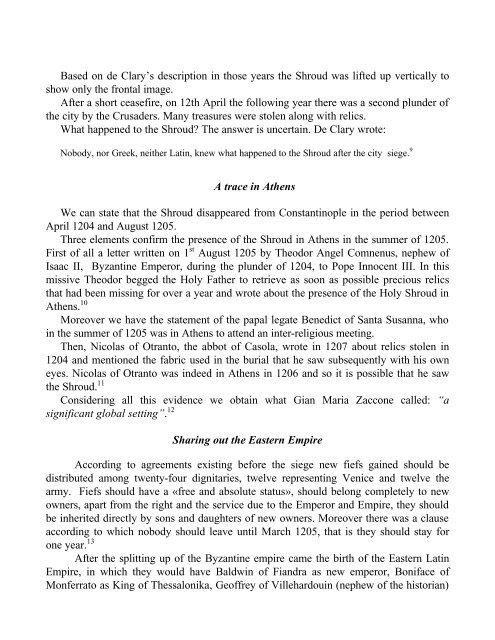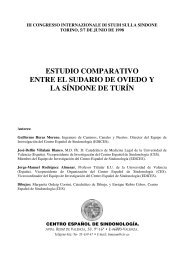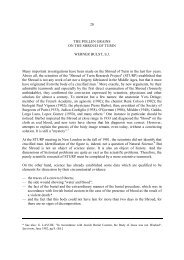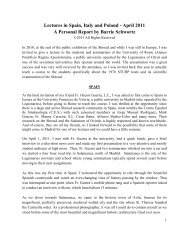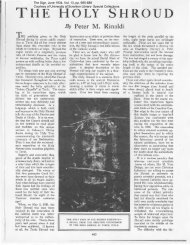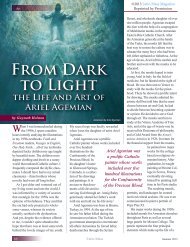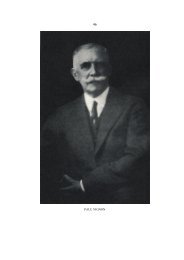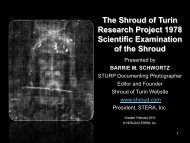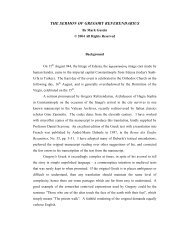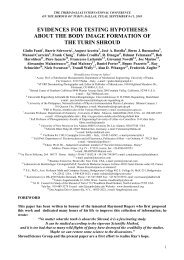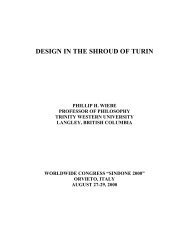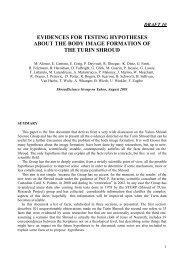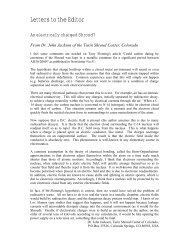Missing Years - Shroud of Turin
Missing Years - Shroud of Turin
Missing Years - Shroud of Turin
Create successful ePaper yourself
Turn your PDF publications into a flip-book with our unique Google optimized e-Paper software.
Based on de Clary’s description in those years the <strong>Shroud</strong> was lifted up vertically to<br />
show only the frontal image.<br />
After a short ceasefire, on 12th April the following year there was a second plunder <strong>of</strong><br />
the city by the Crusaders. Many treasures were stolen along with relics.<br />
What happened to the <strong>Shroud</strong> The answer is uncertain. De Clary wrote:<br />
Nobody, nor Greek, neither Latin, knew what happened to the <strong>Shroud</strong> after the city siege. 9<br />
A trace in Athens<br />
We can state that the <strong>Shroud</strong> disappeared from Constantinople in the period between<br />
April 1204 and August 1205.<br />
Three elements confirm the presence <strong>of</strong> the <strong>Shroud</strong> in Athens in the summer <strong>of</strong> 1205.<br />
First <strong>of</strong> all a letter written on 1 st August 1205 by Theodor Angel Comnenus, nephew <strong>of</strong><br />
Isaac II, Byzantine Emperor, during the plunder <strong>of</strong> 1204, to Pope Innocent III. In this<br />
missive Theodor begged the Holy Father to retrieve as soon as possible precious relics<br />
that had been missing for over a year and wrote about the presence <strong>of</strong> the Holy <strong>Shroud</strong> in<br />
Athens. 10<br />
Moreover we have the statement <strong>of</strong> the papal legate Benedict <strong>of</strong> Santa Susanna, who<br />
in the summer <strong>of</strong> 1205 was in Athens to attend an inter-religious meeting.<br />
Then, Nicolas <strong>of</strong> Otranto, the abbot <strong>of</strong> Casola, wrote in 1207 about relics stolen in<br />
1204 and mentioned the fabric used in the burial that he saw subsequently with his own<br />
eyes. Nicolas <strong>of</strong> Otranto was indeed in Athens in 1206 and so it is possible that he saw<br />
the <strong>Shroud</strong>. 11<br />
Considering all this evidence we obtain what Gian Maria Zaccone called: “a<br />
significant global setting”. 12 Sharing out the Eastern Empire<br />
According to agreements existing before the siege new fiefs gained should be<br />
distributed among twenty-four dignitaries, twelve representing Venice and twelve the<br />
army. Fiefs should have a «free and absolute status», should belong completely to new<br />
owners, apart from the right and the service due to the Emperor and Empire, they should<br />
be inherited directly by sons and daughters <strong>of</strong> new owners. Moreover there was a clause<br />
according to which nobody should leave until March 1205, that is they should stay for<br />
one year. 13<br />
After the splitting up <strong>of</strong> the Byzantine empire came the birth <strong>of</strong> the Eastern Latin<br />
Empire, in which they would have Baldwin <strong>of</strong> Fiandra as new emperor, Boniface <strong>of</strong><br />
Monferrato as King <strong>of</strong> Thessalonika, Ge<strong>of</strong>frey <strong>of</strong> Villehardouin (nephew <strong>of</strong> the historian)


